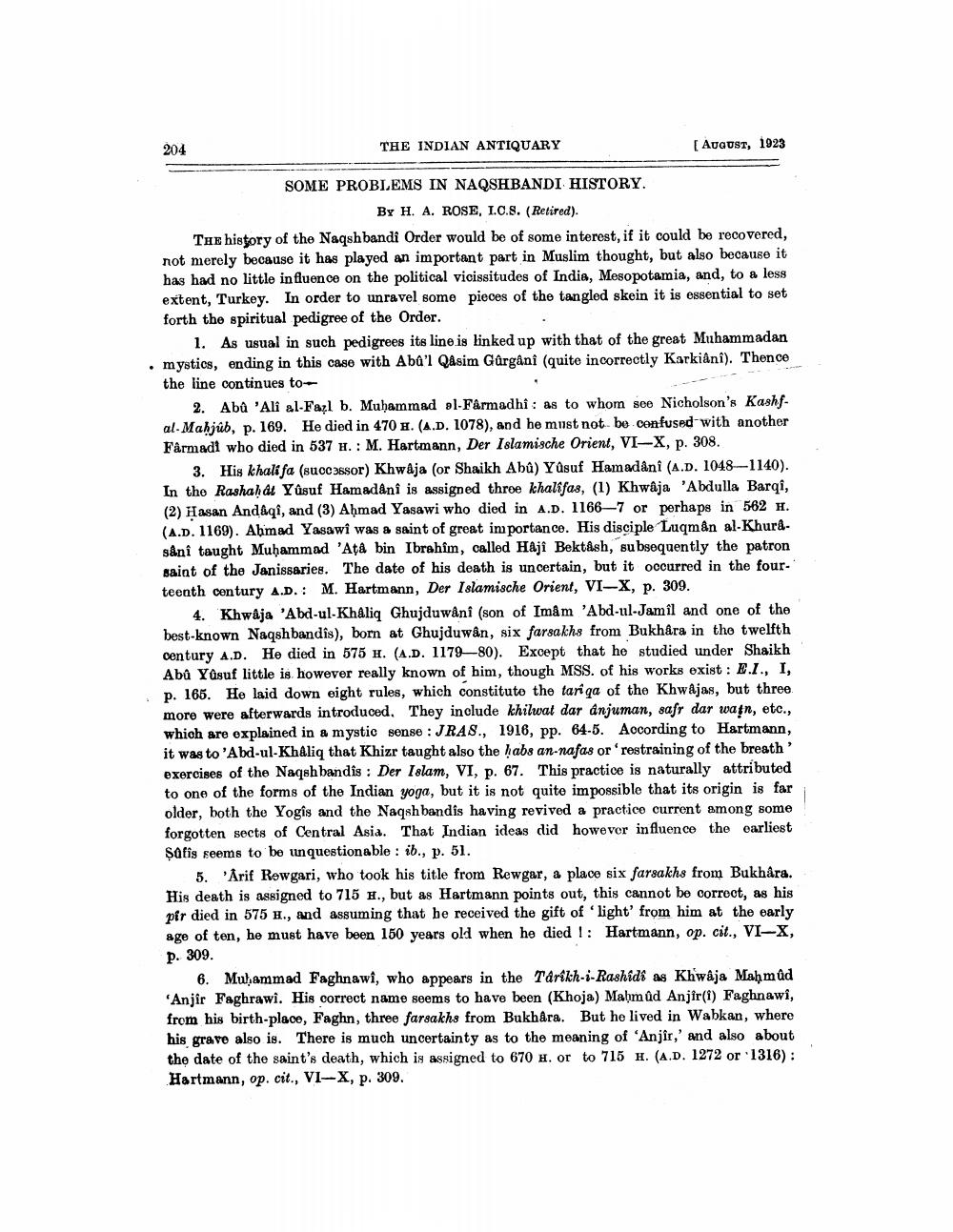________________
204
THE INDIAN ANTIQUARY
[ August, 1923
SOME PROBLEMS IN NAQSHBANDI HISTORY
BY H. A. ROSE, L.C.S. (Retired). The history of the Naqshbandi Order would be of some interest, if it could be recovered, not merely because it has played an important part in Muslim thought, but also because it has had no little influence on the political vicissitudes of India, Mesopotamia, and, to a less extent, Turkey. In order to unravel some pieces of the tangled skein it is essential to set forth the spiritual pedigree of the Order.
1. As usual in such pedigrees its line is linked up with that of the great Muhammadan . mystics, ending in this case with Abu'l Qasim Gürgâni (quite incorrectly Karkiâni). Thence the line continues to
2. Abu 'Ali al-Fayl b. Muhammad al-Fârmadhi: as to whom see Nicholson's Kashfal-Mahjúb, p. 169. He died in 470 . (A.D. 1078), and he must not be confused with another Fârmadt who died in 537 H. : M. Hartmann, Der Islamische Orient, VI-X, p. 308.
3. His khalifa (succəksor) Khwaja (or Shaikh Abû) Yûsuf Hamadani (A.D. 1048--1140). In the Rashahat Yûsuf Hamaddni is assigned three khalifas, (1) Khwaja 'Abdulla Barqi, (2) Hasan Andaqi, and (3) Ahmad Yasawi who died in A.D. 1166–7 or perhaps in 562 H. (A.D. 1169). Ahmad Yasawi was a saint of great importance. His disciple Luqmån al-Khurdsânî taught Muhammad 'Atå bin Ibrahim, called Haji Bektash, subsequently the patron saint of the Janissaries. The date of his death is uncertain, but it occurred in the four. teenth century A.D. : M. Hartmann, Der Islamische Orient, VI-X, p. 309.
4. Khwaja 'Abd-ul-Khaliq Ghujduwâni (son of Imam 'Abd-ul-Jamil and one of the best-known Naqshbandis), born at Ghujduwân, six farsakhs from Bukhara in the twelfth century A.D. He died in 575 H. (A.D. 1179—80). Except that he studied under Shaikh Abû Yusuf little is however really known of him, though MSS. of his works exist : E.I., I, p. 165. He laid down eight rules, which constituto the tariqa of the Khwajas, but three more were afterwards introduced. They include khilwat dar anjuman, safr dar watn, etc., which are explained in a mystic sense : JRAS., 1916, pp. 64-5. According to Hartmann, it was to 'Abd-ul-Khaliq that Khizr taught also the habs an-nafas or restraining of the breath' exercises of the Naqshbandis : Der Islam, VI, p. 67. This practice is naturally attributed to one of the forms of the Indian yoga, but it is not quite impossible that its origin is far older, both the Yogis and the Naqshbandis having revived a practice current among some forgotten sects of Central Asia. That Indian ideas did however influence the earliest Sofis seems to be unquestionable : ib., p. 51.
5. 'Arif Rewgari, who took his title from Rewgar, a place six farsakhs from Bukhara. His death is assigned to 715 H., but as Hartmann points out, this cannot be correct, as his pir died in 575 H., and assuming that he received the gift of 'light' from him at the early age of ten, he must have been 160 years old when he died 1: Hartmann, op. cit., VI-X, P. 309.
6. Muhammad Faghnawi, who appears in the Tarikh---Rashidi as Khwaja Mahmud 'Anjir Faghrawi. His correct name seems to have been (Khoja) Mahmûd Anjir(i) Faghnawî, from his birth-place, Faghn, three farsakhs from Bukhara. But ho lived in Wabkan, where his grave also is. There is much uncertainty as to the meaning of 'Anjir,' and also about the date of the saint's death, which is assigned to 670 H. or to 715 H. (A.D. 1272 or 1316): Hartmann, op. cit., VI-X, p. 309.




